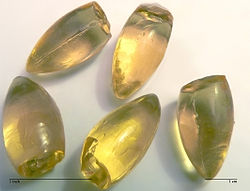Laxatives
Drugs that support the passage of stool. Originally intended to treat constipation, it has become a widely used group. This phenomenon is probably related to a change in people's lifestyle and mindset, according to which every "healthy" person should regularly have at least 1-3 stools a day. Physiologically, however, there are considerable differences between individuals. 3 times a day - 3 times a week can be considered normal. A change against the normal rhythm is mainly diagnostic for each patient. It is always necessary to teach the patient about sufficient intake of fluids and dietary fiber + physical activity. In general, it is better to avoid drug therapy. On the contrary, this must be started if it is diagnosed:
- strangulating stools (e.g. postoperatively);
- hemorrhoids – it is necessary to soften the stool;
- liver failure – the amount of absorbed neurotoxic substances is reduced;
- obstinate constipation induced by medication.
Warning – laxatives are contraindicated in mechanical bowel obstruction. According to the mechanism of action, they can be divided into several categories:
Contact laxative[edit | edit source]
Depending on the mechanism of action, they are irritant or stimulant laxatives. They are only suitable for short-term administration. Chronic stimulation leads to mucosal atrophy, intestinal distension and tolerance - forcing the patient to increase the dose. The cause is damage to the mucosal nerve plexus, which is usually not fully reversible. Administration in pregnancy and lactation is contraindicated.
- Castor oil
- Senna
A plant containing glycosides, which are hydrolyzed by the action of the intestinal flora into active sennoside A and sennoside B. These substances increase the response of the intestine to normal stimuli, therefore it is important to simultaneously administer bulk laxatives (which act as a physiological stimulus here). However, they probably also have a direct stimulating effect on the intestinal wall. After administration, they are rapidly absorbed and reach the large intestine by active secretion. The effect therefore begins with a delay of about eight hours.
Adverse effects - colic and diarrhea in overdose. It turns the urine yellow or red. Melanosis coli – benign pigmentation of the intestinal mucosa caused by the deposition of anthrquinone pigments (released from the drug) in the intestinal mucosa.
- Aloe, cascara
They contain emodin - a natural alkaloid that is absorbed in the small intestine and subsequently actively secreted into the lumen of the large intestine - stimulates motility. The effect begins with a delay of 6-8 hours.
Phenolphthalein, bisacodyl, picosulfate Chemically similar synthetic substances. Significant enterohepatic circulation prolongs their effect and delays its onset by 10 hours.
- Glycerin suppositories
The release of glycerin irritates the rectal mucosa. The effect is practically immediate.
Bulk Laxative[edit | edit source]
- Hydrophilic colloids, agar, tragacanth, methylcellulose, bran
They contain indigestible parts of fruits, vegetables and cereals. In the intestine, upon contact with the contents, they swell and form a bulky gel-like mass, which leads to distension of the intestine and stimulation of motility. At the same time, they bind organic substances (e.g. salts of bile acids - elimination of cholesterol from the body, carcinogens, etc.). Bran is contraindicated in gluten enteropathy.
Osmotic laxative[edit | edit source]
Osmotically active non-absorbable substances - they retain water in the intestine and subsequently distend the intestine and stimulate motility.
- Magnesium sulfate, magnesium hydroxide, sodium sulfate
Non-absorbable inorganic salts. With salts containing magnesium, its partial absorption occurs (they are contraindicated in renal failure) and the subsequent release of cholecystokinin, which facilitates a prokinetic effect on the intestine.
- Lactulose
Synthetic non-absorbable disaccharide (galactose-fructose). In the large intestine, it is transformed into non-absorbable anions (mostly acetic and lactic acid) by the activity of the fermenting microflora, which keep water in the lumen of the intestine. At the same time, the pH of the intestinal contents decreases. This property is advantageous in the therapy of liver failure, where the drop in pH inhibits the proliferation of ammonia-producing microorganisms. The acidic pH of the environment also prevents the absorption of already formed ammonia and its exit through the stool. It is administered orally once a day after breakfast. The effect starts within 2-3 days.
Stool softening laxatives[edit | edit source]
Soft emulsifying substances – facilitate passage through the intestine and defecation.
- Mineral oils (paraffin oil)
A now obsolete group of drugs - the only indication is intoxication with strongly lipophilic substances (gasoline, kerosene, organophosphates) - prevents their absorption and, by speeding up the passage, accelerates elimination in the stool.
Motility Stimulating Laxatives[edit | edit source]
Medicines that directly stimulate the smooth muscle of the intestine. Mainly used in the therapy of functional constipation on the basis of hypomotility and sudden disorders of passage (paralytic - e.g. postoperative paresis)
- Metoclopramide, alizapride, domperidone, cisapride
prokinetics used in the therapy of passage disorders in the stomach area.
- Distigmine, neostigmine, pyridostigmine
Cholinesterase inhibitors. Indicated in the therapy and prophylaxis of postoperative intestinal atony
- Naloxone
In the therapy of constipation accompanying the overproduction of endorphins.
- Yohimbine
Links[edit | edit source]
Related Articles[edit | edit source]
External links[edit | edit source]
References[edit | edit source]
- MARTÍNKOVÁ, Jiřina – MIČUDA, Stanislav – ČERMÁKOVÁ, Jolana. Vybrané kapitoly z klinické farmakologie pro bakalářské studium [online]. ©2001. [cit. 2010-07-16]. <https://www.lfhk.cuni.cz/farmakol/predn/bak/kapitoly/git-bak.doc/>.

